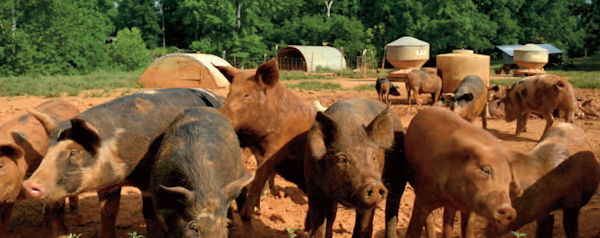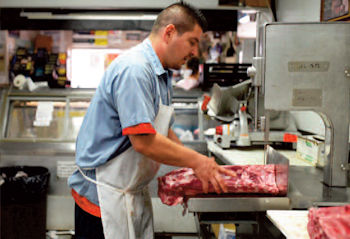SEJournal Online is the digital news magazine of the Society of Environmental Journalists. Learn more about SEJournal Online, including submission, subscription and advertising information.
EJ Academy
By LAURA RUEL
 |
| Dave Hull, farm manager at Tom Butler’s industrial hog farm in Lillington, N.C., greets one of over 6,000 pigs housed in ten hog houses. Photo by Caitlin Kleiboer |
Duplin County, N.C., has more hogs than people — actually about 30 hogs for every person. My state is the second-largest hog producer in the nation, after Iowa.
Yet I was unprepared to hear my students at UNC-Chapel Hill’s School of Journalism and Mass Communication say how they wanted to spend their summer. They wanted to spend seven weeks wading through shit. Pig shit. Hog waste, to be exact.
I’m the executive producer of the school’s acclaimed “Powering a Nation” project, which during the previous five years had focused on student-conceived stories about coal, oil, wind power, water, natural resources and electricity. Initially funded with a grant from the Carnegie and Knight foundations, “Powering a Nation” has become a model for new types of storytelling about U.S. energy use. We had seen much success — from SXSW wins to an Emmy nomination to a Grantham Award of Special Merit.
So I was pumped for another great year when we met in spring 2014 for a “breakfast and brainstorm” session at my home. I couldn’t wait to see what that year’s student group had planned.
After much discussion, they made their choice. I was skeptical at first: Hog waste? Really? But I believed these talented students could choose any topic and make it interesting. What ensued during the next two months was an amazing voyage of discovery.
Hog waste = alternative energy
The pork industry has been raising a stink in North Carolina for years. It’s not just the smell; it’s the air pollution that causes asthma, sinus problems and potentially fatal inflammatory lung conditions.
In fact, a nuisance lawsuit filed against pork producers claims that the odors, gases, particulates, bacteria and other toxins emanating from hog farms have made it almost impossible for people to live safely nearby.
At “Powering a Nation,” we look at energy, and we soon found out about the power of pork.
Attending an alternative energy conference at UNC was part of the students’ preparation for the summer. The students met many of the state and region’s alternative energy experts. But one man stood out.
“When I scanned the conference agenda to see who I wanted to connect with, I saw experts in solar, wind, green transportation and other sustainable energy projects,” said “WholeHogNC” student editor Kelly Creedon. “And then I saw there was a hog farmer on the list, and I knew exactly who I wanted to talk with. At 75, Tom Butler was an unexpected character in the world of renewables, and his quiet but persistent enthusiasm for making energy from hog waste really drew me in.”
The story by Jess Clark and Dree Deacon later described him:
Tom Butler’s business card has the words “Power in the Poop” printed across the creme-colored cardstock. Flip it over, and you’ll see an aerial photo of his farm: 10 narrow hog houses in a neat row along a sandy dirt road. Behind them are three huge, mint-green tarps that Butler uses to cover his “hog lagoons,” or the large pools that collect millions of gallons of hog feces and urine from his 6,000-plus herd.
Butler’s lagoons generate electricity for his farm operations, hence the striking tagline on his business card.
The students could envision the story. Motion graphics could demonstrate the process of how hog waste is converted to electrical energy and sold back to the grid. Researching and explaining this process would challenge these aspiring science reporters. And who doesn’t like bacon? The personalities of hog farmers and ham lovers would add to the engagement of our video stories.
It was a solid plan. But as their research continued, they discovered something else.
The students learned that Butler’s method hasn’t been proven to be profitable or affordable.
 |
| Pigs at Cane Creek Farms, a local community-supported agriculture farm in Efland, N.C. The farm raises hogs naturally — antibiotic and hormone free. Photo by Caitlin Kleiboer |
Challenges ‘pulled apart’
Producing pork means big money for big businesses. A number of credible researchers has proven the ill health effects and the air pollution hog farms cause. The story was much more complex than initially thought.
It became a summer of difficulties. Getting access to the area’s hog farms was challenging. The battle lines in the community had been drawn, and our desire to tell all sides of the stories was challenged by people who were suspicious, frightened and skeptical of our motives.
As the students outlined in the staff editorial:
The history of North Carolina’s pork industry is shaped by community tensions and the struggle for power. Our journalistic exploration of the industry was met with some pushback, ostensibly, at least in part, from fear: fear of losing one’s job, assets, reputation, even livelihood. Perhaps the ultimate irony is that this fear — pitting activist against farmer, corporation against reporter, neighbor against neighbor — is driven by a shared set of values and common goals of maintaining community, family and tradition.
The students knew that their storytelling had to be fair, accurate and trustworthy. Even in this age of multimedia, sometimes the story could be best told with words. With some community members hesitant to be in front of a camera, we used short video clips with well-chosen words in the site section, “Pulled Apart.”
Investigative work about the complexities of the pork industry also challenged the team. Getting quotes “on the record” proved difficult. We used interactive and motion graphics to explain the industry’s growth and carbon footprint. We also did video stories to capture the state’s culture of pork and Butler’s farm operation.
The media matched the messages. The impact was enlightening.
WholeHogNC.org has already won a gold medal in the large group multimedia category of College Photographer of the Year and has been recognized by the professional “Best of Digital Design” competition of the Society for News Design.
How did we accomplish this in about two months?
‘Creativity essential’
 |
|
A butcher trims pork at Cliff's Meat Market in Carrboro, N.C., the destination for locally-raised hogs. Photo by Caitlin Kleiboer |
Creating the right mix of personalities and skills was the crucial first step to success. Our unofficial mantra at UNC’s J-school is similar to many journalism schools today. We want our students to be jacks-of-all-trades, but masters of one.
We chose the students who have shown commitment to their craft because they absolutely love it. They intimately know the strengths and weaknesses of their chosen craft and respect the strengths of others.
Early in the project process, we spent time using “design thinking” methods to work through student ideas. This problem-solving strategy challenges team members to use creativity, original ideas and — sometimes — non-traditional thinking to work through solutions.
What this meant in our newsroom is that no one media form trumped another in the early planning stages. Creativity was essential. If we could do anything, what would we do to make the storytelling as clear, understandable and straightforward as possible?
Granted, this needed to be done quickly. I recall that early team meetings sometimes fell flat. The team didn’t see a clear direction for their work. They were impatient and frustrated.
But — as it always does — results materialized when the time was right. By encouraging (and sometimes expediting) these early stages of design, the collective skills and talents of the group came together and a clear path was laid.
The project coaches and my fellow producers all had to buy into this thinking process. It was essential that we did not let our “coaching” become “directing,” or our “advising” become “dictating.”
Once the students determined their direction, the team had to work non-stop and push to make the project deadline. Here is where the students needed to sometimes stop thinking about the big picture and focus on their individual parts of it.
For WholeHogNC.com, here was the team composition:
- 2 researchers/writers
- 2 photographers/videographers
- 1 graphic artist/designer
- 1 graphic artist/designer/web developer
- 3 full-time producers
- 4 part-time consultants/coaches
Hard work and long hours were no strangers to any team member. The seven weeks of time allotted to produce the project provided us all with a stringent deadline and clear goals.
Tips for your special student projects
No one formula was used to create WholeHogNC.org. I do know that the wide range of teaching, training and instruction our students at UNC receive from faculty in every area — from reporting, to ethics to programming — provided a solid foundation for the team.
I also offer the following tips for anyone preparing to undertake a similar project:
- Choose your team carefully. Pay special attention to students who are talented in one form of media, but respectful of other forms.
- Allow the team to make important decisions. All major decisions about the project must come from the team, not from an individual. Everyone becomes more invested in the project’s success this way.
- Respect the “design thinking” process. Allow the lulls of idea generation and the frenetic pace of project planning to flow naturally. Remind the students that fits and starts are part of the process they must go through.
- Have the team set deadlines. This may be the one area where producers and coaches may be tempted to intervene. But, again, the students will be more dedicated to deadlines if they make the commitment themselves.
- Select coaches with dedication. All coaches must buy into the project process of student-driven ideas and creativity. They, too, must respect other coaches and have a specialty area of expertise. Coaches who want to “take over” can be disruptive. In addition, coaches do not need to be with the team constantly. Having them operate as consultants, working with the students when they ask for guidance, is best.
Laura Ruel has been the executive producer of “Powering a Nation” for the past six years. She is the Hugh Morton Distinguished Associate Professor in the School of Journalism and Mass Communication at UNC-Chapel Hill and teaches interactive design, usability and user experience design.
* From the quarterly newsletter SEJournal, Spring 2015. Each new issue of SEJournal is available to members and subscribers only; find subscription information here or learn how to join SEJ. Past issues are archived for the public here.











 Advertisement
Advertisement 



